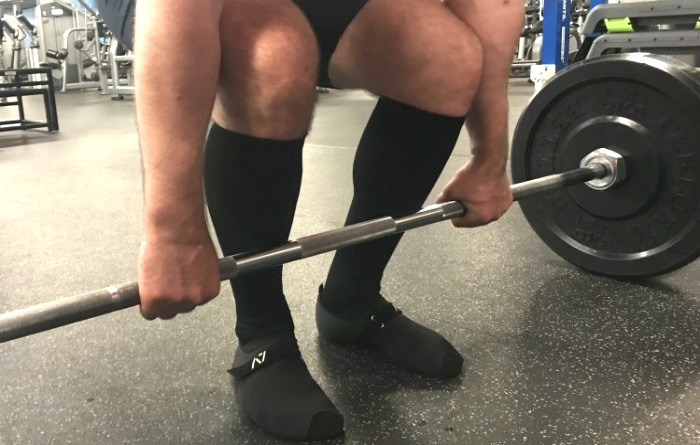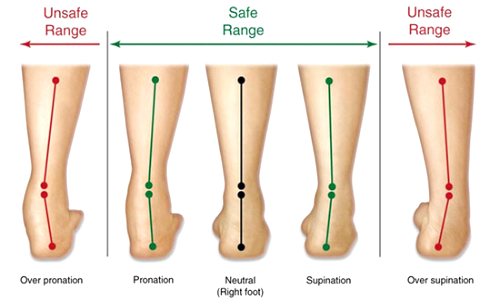
If you are a strength athlete that competes in powerlifting, you probably already know that the sport requires certain equipment if you expect to perform at your peak. Some items like knee sleeves and belts are optional (though not if you expect to compete) while others are simply non-negotiable—powerlifting shoes are an absolute must.
And when it comes to the different types of deadlift shoes out there, slippers reign supreme. With that said, it isn’t black and white—while slippers will be undoubtedly the best for some, they will not be for others. Without further ado, let’s break it down further.
When it comes to the range of options, there are three types to pick from:
- Shoes that provide support around the ankles and often include a metatarsal strap for a tighter, more secure fit
- Slippers that provide the least amount of distance between the pushing force (your feet) and the ground
- Shoes that include a heel—this is the least popular option but some lifters swear by it (you can learn more in this post where deadlifting in weightlifting shoes is covered)
While the last and third option above is very rarely used (weightlifting or squat shoes), the first and third are extremely common. When it comes to selecting between the first two options, there is one main aspect to consider:
Do you perform conventional or sumo deadlifts?
Note: if you only perform one or the other, the segment method on deadlifts will change your mind—do both and get much, much stronger at pulling. Furthermore, choosing a powerlifting program that emphasizes DUP (daily undulating periodization) and intelligent deadlift frequency will maximize your results even more.
Deadlift Slippers Are Hands-Down the Best if You Pull Conventional
If you perform conventional deadlifts exclusively, almost without a doubt deadlift slippers will be your best option. The reason for this is simple: they create the smallest distance possible between your feet and the platform you are pushing against.
To make this point clear, consider an extreme example: deadlifting off of a 2-foot platform. Everyone can agree this would make deadlifts, much more challenging—in fact, deficit deadlifts are done on purpose for this precise reason to promote increased hamstring engagement and promote a stronger pull from the ground.
Now consider the opposite: deadlifting from blocks (also known as rack pulls). Anyone who has performed a set of rack pulls will attest to the large increase in the amount of weight they are able to use.
This leads us to deadlift slippers: in the case of competing and normal pulls, getting as close to the ground as possible is the best option.
Before moving forward it is important to note that nothing is ever black and white. While the physics are clear—the closer to the ground the better—some individuals simply crave the support and stability that shoes can provide.
Why is Wearing Deadlift Slippers Better than Going Barefoot?
That then begs the question: why not deadlift barefoot or in socks?
That is undoubtedly an option and many choose to go this route. However, it comes with several consequences that ultimately make it a less effective option:
- Reduced traction leading to ankle instability and the inability to “grip” the ground as effectively with your toes—when pulling you should always aim to form a “talon” with your toes, creating a three-point connection with your feet where your toes dig into the ground and your heel forcefully pushes down (this should also be done on squats). If you don’t normally grip the ground with your toes in this fashion, try it and you will immediately notice how powerful this simple technique is).
- Instead of pushing against the hard, flat surface found on slippers or shoes you instead are pushing against the floor with nothing in-between. Your feet naturally have compression due to the fat and soft tissue on the bottom of your feet. As we have covered extensively in the powerlifting gear and equipment guide, compression is the enemy of footwear.
On top of these two very important points, pulling barefoot or in socks simply isn’t allowed in competition. If you have been involved with athletics before, you know just how true the old adage is—train how you compete. Getting used to deadlifting barefoot and trying to switch on meet day is a poor decision and will undoubtedly lead to frustration when you find switching over isn’t as simple and smooth as you believed it would be.
But what if you perform sumo deadlifts? Should you still opt to use deadlift slippers?
This is where things get more complicated.
Deadlift Slippers for Sumo Pulls: It’s More Complicated
While the physics don’t change and it is still best to be as close to the floor as possible when pulling, there is one large issue when slippers for sumo deadlifts: the outward torque of proper form can throw off balance and lead to improper form or a missed lift.
If you are familiar with proper technique, you know that producing externally-rotated force is essential for squats and deadlifts. This does not mean that you must have your feet as externally rotated (outward facing) as possible—it simply means you should be “torqueing” your feet externally as you grip the ground. This helps to engage your glutes, tighten your lower back, and form a solid connection with the ground that translates to more weight being lifted.
When you lack the stability and ankle support that traditional deadlift shoes provide, this externally-rotated force can throw you off balance or cause your ankles to become overly pronated or supinated—a good way to get seriously injured.

As always, experience and real-world pragmatism will always beat out opinion and it is best to look at the data as well as examples of elite-level powerlifters. One such lifter is Sean Noriega who, while always pulling in sumo, wears slippers.
https://www.instagram.com/p/BjvtMiglr3f/
While he pulls sumo in slippers, it is important to pick apart a few critical details:
- His stance width is not extremely wide—if it was, he would undoubtedly have much less balance.
- His foot positioning, while quite externally-rotated, is not extreme. If his feet ran more parallel with the barbell, his balance would also be negatively affected.
From these deductions we come to two conclusions:
- If you pull sumo, but do not have an extremely-wide foot position, wearing slippers is likely okay
- If you pull sumo, but have a relatively forward-facing foot position, donning slippers is likely fine
At this point, after understanding the pros and cons and the reasons behind each, you are likely seeking a concrete answer on whether you should pick slippers or shoes. While everyone is unique and there is no one-size-fits-all answer, 95% of people will agree and benefit from the following:
- If you pull conventional, get slippers
- If you pull sumo with a wide or have external outward rotation of your feet, wear shoes
- If you pull sumo but maintain a narrow width with more of a forward-facing foot position, wear slippers
Ultimately, the very best option is to try out both to see what feels and works best. Luckily, while trying out different powerlifting belts can get expensive quickly, slippers are relatively cheap (no more than $20-$30 depending on what brand you go with).
While the debate about which type of deadlifting footwear to choose isn’t cut and dry, having proper footwear absolutely is. If you are used to pulling in chucks or worse, running/tennis shoes, making this simple switch to wearing the proper attire on your feet can literally add 10-30 pounds to your lift overnight. It seems like a dramatic exaggeration that couldn’t possibly be true, but try it for yourself and you will quickly understand why spending the time, money, and effort to acquire the proper gear is well-worth it if your goal is to absolutely maximize your strength and powerlifting potential.
